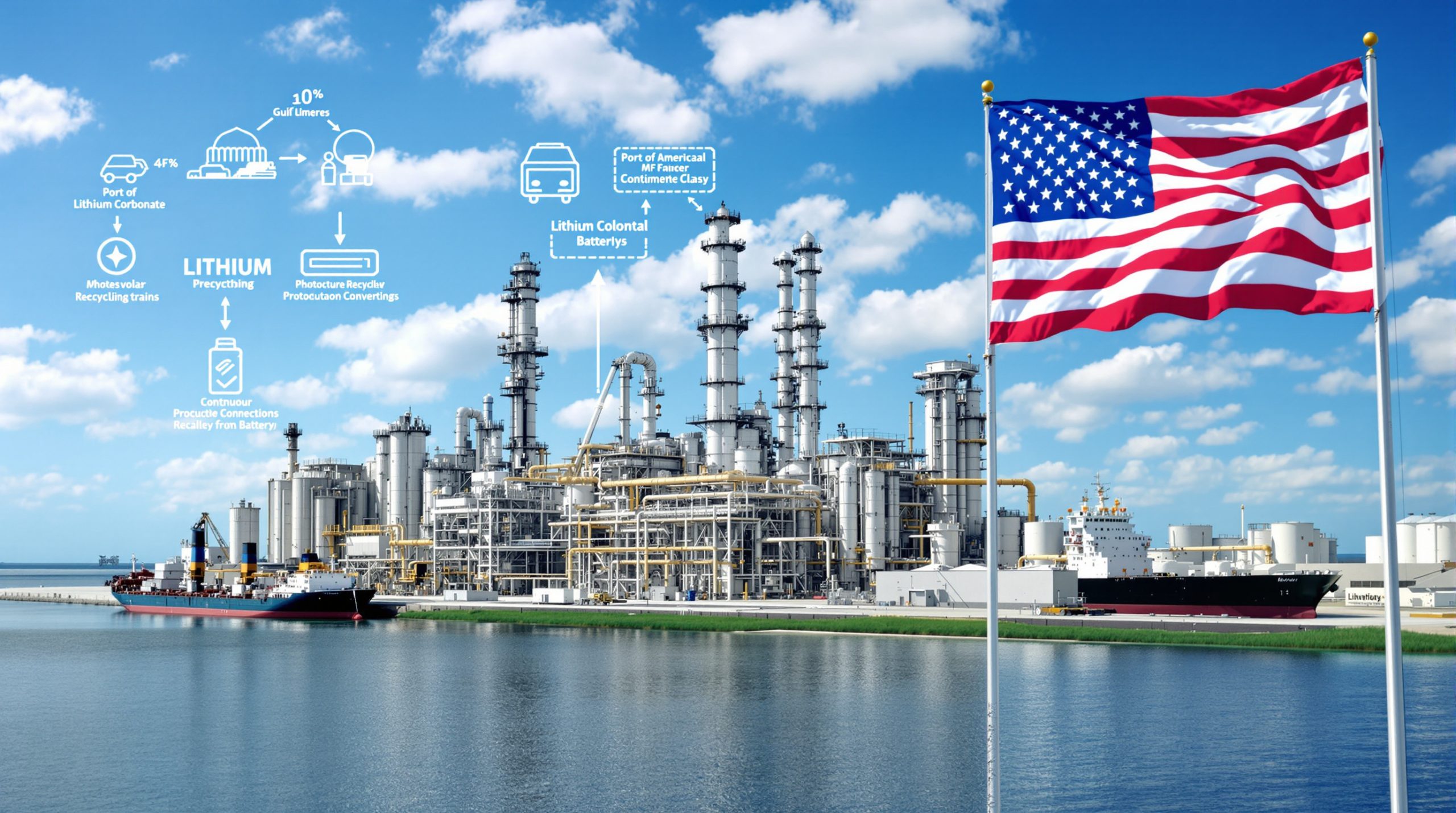Understanding the Global Uranium Enrichment Capacity Deficit
The nuclear fuel cycle is facing a critical bottleneck that threatens energy security worldwide. While much attention focuses on uranium mining and reactor construction, the midstream enrichment process represents the most significant supply constraint in the nuclear fuel cycle. Current enrichment capacity is projected to fall significantly short of demand by 2034, creating strategic vulnerabilities for Western economies and opportunities for aligned uranium producers. The ongoing uranium market volatility has only heightened concerns about this global uranium enrichment capacity deficit.
The Enrichment Process Explained
Uranium enrichment increases the concentration of the fissile isotope U-235 from its natural state of 0.711% to the 3-5% required for conventional nuclear reactors. This process is measured in Separative Work Units (SWUs), which quantify the energy and infrastructure needed to separate uranium isotopes. For institutional investors evaluating uranium equities, understanding SWU dynamics is as essential as tracking reserve grades or production costs.
Natural uranium contains approximately 0.711% U-235 (fissile isotope) and 99.284% U-238. The enrichment process concentrates this U-235 content to make it usable in most commercial reactors. This seemingly technical aspect of the fuel cycle has enormous implications for the entire nuclear industry and uranium market.
Current Global Enrichment Landscape
The global enrichment market is dominated by four main players:
| Enrichment Provider | Annual Capacity (million SWUs) | Global Market Share |
|---|---|---|
| Rosatom (Russia) | 27 | ~40% |
| Urenco (UK/Netherlands/Germany) | 18 | ~21% |
| Orano (France) | 7.5 | ~13% |
| CNNC (China) | 12.5 | ~14% |
| Others | 12 | ~12% |
Russia's dominance in enrichment capacity mirrors Europe's previous dependence on Russian natural gas, creating a strategic vulnerability that Western governments are now working to address.
According to the World Nuclear Association's 2024 report, Russia's position is even more dominant than many realize, with Rosatom controlling approximately 40-44% of global enrichment capacity through its approximately 26.6 million SWU/year operations.
How Severe Is the Projected Enrichment Deficit?
Accelerating Demand Projections
Global enrichment requirements are growing at unprecedented rates, driven by several factors:
- Nuclear power renaissance as countries pursue net-zero carbon targets
- Extended lifespans for existing reactors
- New reactor construction in China, India, and emerging markets
- Small Modular Reactor (SMR) deployment beginning in the late 2020s
- Growing demand for High-Assay Low-Enriched Uranium (HALEU)
Under the Reference Scenario, enrichment demand is projected to grow at a 5.6% compound annual growth rate through 2040, reaching approximately 120 million SWUs annually. The Upper Scenario, incorporating accelerated SMR deployment and extended reactor lifespans, projects a 7.8% CAGR, pushing demand toward 165 million SWUs by 2040.
According to the International Atomic Energy Agency's September 2024 projections, global nuclear capacity could reach between 439-602 GW(e) by 2040, depending on the scenario. This represents significant growth from the current approximately 371 GW(e) from 436 operational reactors worldwide.
Supply-Demand Imbalance Timeline
Current global enrichment capacity stands at approximately 65-70 million SWUs annually, not 90 million as sometimes claimed. According to the World Nuclear Association's supply of uranium, while nameplate capacity may approach 96 million SWU/year globally, the effective commercial capacity available to Western utilities is significantly lower when excluding Russian supplies.
Even with planned expansions by Urenco, CNNC, and Orano, projections indicate:
- Reference Scenario: Global deficit beginning after 2034
- Upper Scenario: Deficit arriving earlier (2030-2032) and deepening significantly
This structural deficit represents a multi-year investment opportunity for uranium producers aligned with Western enrichment infrastructure.
A typical 1,000 MWe light water reactor requires approximately 100,000-120,000 SWU per year for initial fuel loading and annual refueling. With 60-80 new reactors expected to begin operation by 2030-2035, this represents an additional 6-10 million SWU/year demand beyond current capacity.
Why Is Western Fuel Cycle Independence Critical?
Russian Dominance and Strategic Risks
Russia's Rosatom controls approximately 27 million SWUs of annual enrichment capacity, representing nearly one-third of the global total. Western utilities have historically relied on Russian enrichment services due to cost competitiveness and reliability.
However, geopolitical tensions have exposed the vulnerability of this dependency:
- The United States sources roughly 25% of its enrichment services from Russia
- European utilities have similar exposure to Russian enrichment
- Western sanctions have complicated payment mechanisms and logistics
According to the U.S. Energy Information Administration, in 2022, U.S. utilities purchased approximately 12% of their uranium from Russia, while Russian enrichment services represented approximately 24% of enrichment SWU delivered to U.S. utilities that year.
Western Diversification Initiatives
In response to these vulnerabilities, Western governments are implementing policies to secure domestic fuel cycles:
- The U.S. has moved to ban on Russian uranium imports
- The Department of Energy has established funding programs for domestic enrichment
- European utilities are accelerating diversification efforts
- Canada and Australia are exploring expanded roles in the fuel cycle
President Biden signed the "Prohibiting Russian Uranium Imports Act" into law on May 13, 2024, which bans imports of LEU from Russia effective August 11, 2024, with certain waiver provisions through January 1, 2028 for utilities without alternative sources.
At the May 2023 G7 Summit in Hiroshima, leaders committed to "reducing dependency on civil nuclear goods and services from Russia" and establishing secure nuclear fuel supply chains among allied nations.
These initiatives are creating premium pricing opportunities for uranium producers capable of feeding Western enrichment infrastructure.
How Does Conversion Capacity Affect the Enrichment Deficit?
The Conversion Bottleneck
Conversion facilities transform uranium concentrate (yellowcake) into uranium hexafluoride (UF₆), the chemical form required for enrichment. This represents another critical bottleneck in the nuclear fuel cycle:
- Under the Reference Scenario, conversion requirements are projected to rise at a 5.5% CAGR
- Global conversion capacity is concentrated in facilities in France, Canada, the U.S., Russia, and China
- Western conversion capacity operates near full utilization
- Several facilities face aging infrastructure and regulatory constraints
According to World Nuclear Association data, global conversion capacity is distributed among:
- Cameco (Canada): Blind River (24,000 tU/year) and Port Hope (12,500 tU as UF6/year)
- Orano (France): Malvési and Tricastin facilities (~15,000 tU/year)
- ConverDyn (USA): Metropolis Works facility (~15,000 tU/year capacity, currently operating at reduced capacity)
- Rosatom (Russia): ~30,000 tU/year
- CNNC (China): ~15,000 tU/year and expanding
Interdependent Supply Chains
The interdependence between conversion and enrichment creates a multiplier effect on uranium demand:
- Enrichment capacity expansion requires parallel scaling of conversion facilities
- Conversion bottlenecks can constrain enrichment throughput
- Supply disruptions in either segment ripple through the entire fuel cycle
The conversion process transforms uranium ore concentrate (U3O8 – yellowcake) into uranium hexafluoride (UF6) through multiple chemical steps. UF6 is the only uranium compound suitable for enrichment because it sublimes at relatively low temperature (56.5°C), making it essential for the enrichment process.
Producing 1 kg of 4% enriched uranium requires approximately 8-10 kg of natural uranium feed (depending on tails assay), and this natural uranium must first be converted to UF6, demonstrating how conversion capacity must match or exceed uranium production levels.
Western governments are increasingly viewing the entire front-end fuel cycle as critical infrastructure, implementing policies to support domestic capacity across all segments.
What Role Will Small Modular Reactors Play in the Enrichment Deficit?
SMR Deployment Timeline and Impact
Small Modular Reactors represent a paradigm shift in nuclear technology, offering scalable, factory-fabricated designs with reduced construction timelines and capital intensity. Many SMR designs require High-Assay Low-Enriched Uranium (HALEU) fuel enriched to between 5% and 19.75% U-235.
According to the International Atomic Energy Agency:
- Conservative estimate: 25-50 SMRs operational globally by 2030
- Optimistic estimate: 100+ SMRs by 2035
- Each 300 MWe SMR requires approximately 30,000-40,000 SWU annually for HALEU fuel
Under the Reference Scenario, generic SMR deployment is expected to require:
- Initial commercial HALEU deliveries by 2026-2028
- Approximately 3.7 million SWUs annually by 2035
- Over 13.7 million SWUs annually by 2040
The Upper Scenario envisions accelerated SMR adoption with:
- Commercial-scale deployments beginning in the late 2020s
- SWU requirements increasing by an average of 1.8 million annually
- Exceeding 29 million SWUs of annual requirements by 2040
HALEU Production Challenges
HALEU production presents unique challenges:
- Higher enrichment levels require proportionally more SWUs
- Commercial-scale HALEU production in the West remains limited
- Specialized transportation and handling infrastructure is needed
- Regulatory frameworks are still evolving
As of October 2024, HALEU production capacity is extremely limited:
- United States: Limited demonstration-scale production only
- Centrus Energy: AC100M cascade in Piketon, Ohio producing small quantities
- Target: 900 kg/year demonstration capacity
- Russia: Rosatom has commercial HALEU production capability (primary global supplier)
- China: Developing HALEU capability
- Western commercial-scale production: Essentially zero
The Department of Energy has established the HALEU Availability Program, contracting with Urenco, Centrus Energy, and Orano to develop domestic HALEU supply. This creates additional pressure on an already constrained enrichment system.
How Are Pricing Dynamics Responding to the Enrichment Deficit?
Market Segmentation and Premium Pricing
The enrichment deficit is creating market segmentation and premium pricing opportunities:
- Western utilities are paying premiums for secure, non-Russian enrichment services
- Long-term contracting is increasing as utilities seek supply security
- Spot market liquidity is decreasing as suppliers prioritize strategic customers
- Price discovery is becoming more challenging as transactions move to private negotiations
This market fragmentation benefits uranium producers with secure access to Western conversion and enrichment infrastructure, who can capture premium pricing for their feedstock.
High-grade deposits offer economic advantages in HALEU supply chains due to lower conversion costs and reduced environmental footprint per unit of output.
Capital Market Response
Institutional investors are recognizing the strategic importance of the enrichment deficit:
- Western uranium equities are trading at enterprise value per pound premiums
- Development capital is flowing into the sector at unprecedented levels
- Utilities are making strategic investments in producers to secure supply
- Technology companies with significant energy requirements are moving upstream in the nuclear fuel cycle
Energy Fuels raised $600 million through a convertible note offering to advance their projects, while other companies have completed equity placements to fund development. This reflects growing institutional recognition of the strategic value of Western-aligned uranium production.
Companies with low all-in sustaining costs and scalable infrastructure are best positioned for margin expansion as enrichment tightens.
Which Uranium Producers Are Positioned to Benefit?
Strategic Positioning Criteria
Uranium producers best positioned to benefit from the enrichment deficit share several characteristics:
- Access to Western conversion and enrichment infrastructure
- Operations in politically stable jurisdictions
- Favorable cost structures
- Scalable production profiles
- Strong relationships with Western utilities
Key Beneficiaries in North America
United States domestic producers offer direct access to U.S. conversion and enrichment infrastructure:
-
U.S. Conventional Producers: Companies operating traditional mining and milling operations in states like Utah and Wyoming benefit from proximity to domestic processing infrastructure and government prioritization of domestic supply.
-
U.S. In-Situ Recovery Operators: In-situ recovery operations in Texas and Wyoming offer scalable production with lower capital intensity, positioned to feed domestic conversion facilities. These operations contribute significantly to US uranium production insights.
Canadian producers provide jurisdictional stability and established export channels to the U.S.:
-
Athabasca Basin Developers: Companies with high-grade deposits in Saskatchewan's Athabasca Basin benefit from exceptional grades and established toll milling arrangements.
-
Canadian Explorers: Exploration companies with significant Athabasca exposure offer leverage to future supply constraints through resource development potential.
Global Strategic Suppliers
Several global producers are strategically aligned with Western fuel cycle independence:
-
African Producers: Operations in Niger and Namibia provide non-Russian, non-Kazakhstani supply sources with established export channels to Europe and North America. However, some operations like the Paladin Energy uranium halt in Namibia have temporarily reduced available supply.
-
Australian Developers: Australia's stable regulatory environment and historical role as a major uranium exporter position its producers as strategic suppliers to Western markets.
What Is the Investment Thesis for Uranium Amid the Enrichment Deficit?
Core Investment Pillars
The uranium investment thesis amid the enrichment deficit rests on five core pillars:
-
Structural Demand Growth: Enrichment requirements are projected to grow beyond installed capacity, with a global deficit likely after 2034 and earlier under accelerated SMR deployment scenarios.
-
Policy-Driven Repricing: Western governments are implementing policies to localize the fuel cycle, creating durable tailwinds for domestic producers.
-
Front-End Leverage: Companies supplying uranium concentrate into Western circuits are positioned to capture premium pricing as utilities prioritize supply chain security.
-
High-Grade Optionality: Explorers and developers with high-grade resources offer asymmetric upside as SMR demand scales and HALEU programs mature.
-
ESG Alignment: Environmental, social, and governance considerations are converging with security priorities, directing capital flows toward projects aligned with government policy and environmental standards.
Long-Term Structural Change
The enrichment deficit represents not a temporary imbalance but a structural constraint reshaping uranium markets through 2040. As governments anchor nuclear policy around energy security, uranium producers capable of feeding the front end of the cycle become critical infrastructure rather than commodity suppliers.
For institutional investors, the opportunity lies in identifying producers with:
- Secure access to Western conversion and enrichment infrastructure
- Favorable cost structures
- Jurisdictional alignment with policy priorities
The uranium investment thesis has evolved beyond mine supply; it now centers on fuel cycle integration and energy independence. Furthermore, recent US uranium market disruptions have only underscored the importance of a diversified, secure supply chain.
What Are the Key Risks to the Enrichment Deficit Thesis?
Potential Mitigating Factors
Several factors could potentially mitigate the projected enrichment deficit:
-
Accelerated Capacity Expansion: Faster-than-expected capacity additions by Western enrichers could reduce the deficit timeline.
-
Underutilized Russian Capacity: Continued access to Russian enrichment services for certain markets could alleviate global pressure.
-
Tails Re-Enrichment: More aggressive re-enrichment of depleted uranium tails could supplement primary production.
-
Advanced Technology Deployment: Next-generation laser enrichment technology could increase efficiency and reduce capacity requirements.
-
Reactor Deployment Delays: Slower-than-projected reactor construction or SMR commercialization could reduce demand growth.
Monitoring Indicators
Investors should monitor several indicators to assess the enrichment deficit trajectory:
- Enrichment term contract pricing and duration trends
- Capacity expansion announcements from major enrichers
- Government policy developments regarding fuel cycle independence
- Utility inventory management strategies
- SMR deployment timelines and regulatory approvals
Conclusion: The Strategic Imperative of Enrichment Capacity
The global uranium enrichment capacity deficit represents a fundamental reshaping of nuclear fuel markets. As Western economies prioritize energy security and fuel cycle independence, the enrichment bottleneck creates both strategic vulnerabilities and investment opportunities.
For uranium producers, alignment with Western enrichment infrastructure offers premium pricing potential and strategic positioning. For utilities and governments, securing domestic enrichment capacity becomes a national security imperative rather than merely an economic consideration.
The coming decade will see unprecedented investment in enrichment capacity expansion, creating a favorable environment for uranium producers capable of delivering feedstock into constrained Western circuits. This structural shift transforms uranium from a commodity play to a strategic resource, with corresponding implications for valuation and capital allocation.
FAQs About the Global Uranium Enrichment Capacity Deficit
What is a Separative Work Unit (SWU) and why does it matter for uranium investors?
A Separative Work Unit measures the effort required to enrich uranium by separating U-235 from U-238. It's the core metric for tracking enrichment capacity and demand, similar to how barrels measure oil production. Investors should monitor SWU dynamics because enrichment capacity constraints directly affect how much mined uranium can be converted into reactor fuel, creating bottlenecks that drive uranium pricing.
Why is there concern about a global enrichment capacity deficit after 2034?
Current global enrichment capacity stands at approximately 65-70 million SWUs annually, but demand is projected to grow 5.6-7.8% per year through 2040, reaching 120-165 million SWUs depending on the scenario. Even with planned expansions by Urenco, Orano, and CNNC, the gap between demand and supply widens significantly after 2034, particularly under accelerated Small Modular Reactor deployment scenarios.
How does Russia's dominance of enrichment capacity affect Western energy security?
Russia's Rosatom controls approximately 40-44% of global enrichment capacity, with the United States sourcing roughly 25% of its enrichment services from Russia. This creates strategic vulnerability similar to Europe's previous dependence on Russian natural gas. Western governments are now banning Russian enriched uranium imports and investing in domestic enrichment capacity, driving demand for secure, non-Russian uranium feedstock.
What role do Small Modular Reactors play in future uranium demand?
Small Modular Reactors require High-Assay Low-Enriched Uranium (HALEU) fuel enriched to 5-19.75% U-235, significantly higher than conventional reactors' 3-5%. By 2035-2040, SMRs are expected to require 13.7 million SWUs annually under the Reference Scenario, potentially exceeding 29 million SWUs under accelerated deployment. This creates incremental uranium demand because each kilogram of HALEU requires more natural uranium feedstock than conventional Low-Enriched Uranium.
Which uranium producers are best positioned to benefit from the enrichment bottleneck?
Producers with access to Western conversion and enrichment infrastructure hold strategic advantages. United States domestic producers benefit from government prioritization of domestic supply. Canadian producers with high-grade deposits offer jurisdictional stability and established export channels to U.S. processing infrastructure. Companies aligned with Western fuel cycle localization are positioned to capture premium pricing as utilities prioritize supply chain security.
Further Exploration:
Readers interested in learning more about the global uranium enrichment capacity deficit can also explore related educational content on uranium market dynamics and nuclear fuel cycle economics through industry publications and specialized investment research.
Ready to Spot the Next Major Mineral Discovery?
Stay ahead of the market with Discovery Alert's proprietary Discovery IQ model that instantly identifies significant ASX mineral discoveries, turning complex data into actionable investment insights. Explore our dedicated discoveries page to understand why historic discoveries have generated substantial returns for early investors.




